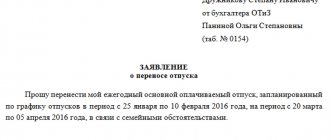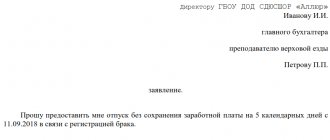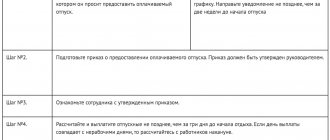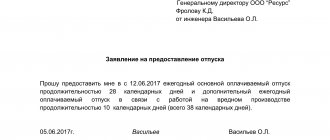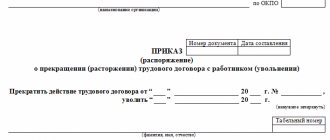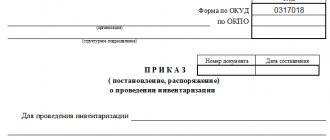The document on the basis of which employees are granted leave of one type or another is an order. It is important to draw it up correctly in order to avoid both problems with inspection authorities and misunderstandings with the hired person in the future. In this article we will talk about the rules by which the document is formed and its features when granting leaves of various types. You will also find a sample vacation order here.
Payroll and personnel records
Basic Rules
In accordance with the Labor Code of the Russian Federation, other Russian laws, an employment contract and internal regulations, the employer provides the hired person with various types of leave. The algorithm for their design is approximately the same:
- we receive an application from the employee (not required if leave is provided according to a schedule), and in some cases additional documents;
- we issue a vacation order;
- we sign it with the manager;
- we introduce him to the employee against his signature;
- We transfer a copy to the accounting department to calculate payment.
Whatever the leave may be - annual paid, without pay, maternity leave or otherwise - before it begins, an order is drawn up to grant leave to the employee. This is a local regulation that gives a person the right to be absent from the workplace for a specified period of time for a specific reason.
Why is it needed?
A leave order is required to document the absence of an employee from the workplace.
When issuing such an order, the manager is obliged to notify the subordinate, against signature, of the date of receipt of rest no later than 2 weeks before its allocation (Article 123 of the Labor Code of the Russian Federation). Notification can be made by signing the future vacationer in an order or other document (Rostrud Letter No. PG/5883-6-1 dated 08/01/2012). Based on this order, the personnel officer makes a record of this fact in the subordinate’s personal card (form No. T-2), indicating the date of departure for rest and return to work.
When allocating vacation according to the vacation schedule, a personal card in form No. T-7 is also filled out. In this option, regardless of the presence of a vacation order, the subordinate person has the right to go on vacation in accordance with Art. 123 Labor Code of the Russian Federation. At the same time, he must be paid vacation pay 3 days before it starts.
The head of the institution is also interested in issuing an order and familiarizing the employee with it, since in the absence of such an order the Labor Inspectorate may punish him.
How to create an order
Until 2013, the T-6 form was used to issue a vacation order (approved by Resolution of the State Statistics Committee dated January 5, 2004 No. 1). There is no need to use it now. However, it contains all the necessary details, and many employers still use it as a vacation order.
Only a few fields need to be filled in the form, and the order is ready. It reflects the following information:
- Name of the organization;
- order number and date of its preparation;
- Full name of the employee and his personnel number;
- the structural unit in which he works, as well as his position;
- type of leave;
- the period for which the leave was granted, the number of days or the period during which the employee will be absent (depending on the type of leave, blocks “A” and/or “B” are filled in);
- total duration of the vacation period (in block “B”). If only one type of leave is provided, its period must also be duplicated in this line.
An order for granting leave is usually prepared by the HR department. The basis is any document, which depends on the type of vacation. A copy of the approved document is sent to the accounting department. Information about leave based on the order must be entered into the employee’s personal card.
Let's sum it up
- Leave in advance can be taken out during any period of work with a particular employer, despite the presence in the legislation of a clause stating that the right to leave arises only after six months from the date of employment. The issue of its provision, as a rule, is decided by agreement with the employer. An exception is the situation when a person who has the right to freely choose the time of rest requests early leave before the completion of the first six months of work.
- The procedure for registering leave in advance does not differ from the standard one: employee application, employer consent, leave order. The order itself does not require dividing either the period for which leave is given or the number of its days into those related to time already worked and time not yet worked. The period for which leave is granted is indicated in its entirety, without taking into account possible subsequent deviations that affect its length.
Hello Guest! Offer from "Clerk"
Online professional retraining “Accountant on the simplified tax system” with a diploma for 250 academic hours . Learn everything new to avoid mistakes. Online training for 2 months, the stream starts on March 1.
Sign up
Annual leave
An order for annual paid leave is drawn up based on the vacation schedule. Often employers insist that employees additionally write a leave application. However, if it is provided on schedule, then this is unnecessary. It’s another matter when vacation is granted outside the schedule - this option is possible by agreement of the parties. In this case, the employee must write a statement.
A common question: how many days before vacation should an order be issued? The legislation does not regulate the exact deadline for completing this document. However, Article 123 of the Labor Code of the Russian Federation states that the employee must be informed about the onset of vacation at least 2 weeks in advance. It is up to the employer to decide how exactly to do this. In practice, it has turned out that this function is performed by the order to grant leave to the employee. This means that it must be issued at least 14 days before the start of the vacation.
If it is customary at the enterprise to act differently (for example, the employee is given a notice 2 weeks in advance), then the order can be drawn up later. It is only important to remember that without it, the accounting department will not be able to calculate and transfer vacation pay. Payment must be made no later than 3 days before the start of the vacation. So, in any case, there is no point in delaying the order.
The peculiarity of drawing up an order for granting annual leave to an employee using the T-6 form is that it is necessary to fill out block “A”. You must indicate the number of calendar days the employee is absent, the start and end date of the vacation. The line “for the period of work” is also filled in - it reflects the period for which annual leave is due.
Additional paid leave
Some categories of employees receive additional vacation days. For example, those working in the Far North are entitled to an additional 24 calendar days. And those who work irregular hours are given an additional 3 days. If an employee’s working conditions are considered dangerous and/or harmful, he is entitled to at least 7 additional vacation days annually. The exact duration of such leave must be specified in the employment contract - it depends on the results of a special labor assessment and on industry agreements.
Annual and additional paid leave can be granted consecutively. In this case, in the T-6 form, each of them is indicated separately: in block “A” data on regular leave is reflected, in block “B” – on additional leave. In block “B” the total duration is indicated, that is, the days and periods of both vacations are summed up.
The T-6 form is filled out using the same principle if an employee takes two different types of leave in a row, for example, annual, and then “without pay.”
Director's leave order
The director, for the most part, is a hired employee like the staff working under his leadership, and he also needs rest. Moreover, according to Law No. 14-FZ of 02/08/1998 and Law No. 208-FZ of 12/26/1995, it has the status of a personal order. However, he does not have the right to go on vacation on his own. His rights and obligations are usually reflected in the charter of the enterprise, which should indicate who makes the decision on granting him vacation days. This could be a board, directorate or a meeting of authorized participants, etc. The decision is documented in a protocol. The employee who is assigned the duties of a director who is on vacation is also designated here.
Based on the protocol drawn up, an order for the chief’s leave is published. It can be published, like orders for personnel, on any form (standard - T-6 or in a custom style).
If the order is published on the standard T-6 form, then the manager himself can sign it. When publishing an order on any form, an authorized representative of the board can sign it.
How to correctly fill out an order for a director’s vacation in 2022
If the company's Charter states that leave to the director is allocated by decision of the general meeting of participants (for example, by the board of directors), then his appointment will be carried out according to the following procedure:
- The director provides the meeting with a written notice indicating the date and duration of the rest. An example statement could be as follows:
- The meeting makes a decision to grant the manager a vacation or to postpone it to another period. The decision is formalized in a protocol, notifying the manager of the upcoming vacation 14 days in advance, like other personnel, according to the Labor Code of the Russian Federation.
- An order for the boss’s leave can be signed either by him or by an authorized person noted in the Charter or minutes of the meeting. This depends on the type of form used. When an order is published on standard T-6 form, only the director has the right to approve it.
- The director also signs acquaintance with the order.
Protocol example
Sample
Download
- Form, doc
- Sample, doc
Vacation without pay
This type of leave can be issued either on certain grounds or without them, that is, simply at the request of the employee (if the employer agrees). The reasons may be: the birth of a child in the family, the death of a close relative, marriage, studying at a state university or entrance exams. In addition, such leave is provided to disabled people (up to 60 calendar days per year), pensioners (up to 14 days), members of election commissions, family members of military personnel or employees of internal affairs bodies and other categories of workers.
In the above cases, as well as in some others, the employer cannot refuse the employee leave without pay. But only on the condition that he submits the relevant document. For example, when requesting student leave, a certificate of summons from an educational institution is required, when requesting leave by a disabled employee, a certificate of disability, and so on. In some cases, such documents may be provided after the vacation. This applies in particular to birth, death or marriage certificates. After all, the employee will receive these documents later than the period for which he requires a break from work.
If there is no documentary evidence of the need for leave, the employer has the right to refuse it. The issue of providing vacation without payment in the absence of legally established grounds is resolved by agreement of the parties.
To receive leave at his own expense, the employee must write an application. Based on it, as well as on the basis of the submitted documents, an order for leave without pay is issued. The line “for the period of work” is not filled in, since the vacation is not related to the time worked. Instead of block “A”, block “B” is filled in. Here you need to reflect the type of leave (without pay), indicate the number of calendar days, start and end dates. If its necessity is confirmed by a document, its details should also be entered in line “B”. Information about the duration and period of vacation must be duplicated in block “B”.
How to register when wages are not saved?
Leave at your own expense refers to the temporary release of an employed person from work without pay. To receive such leave, the employee must submit a petition to the director of the enterprise, indicating the circumstances that arise for the need for the vacation provided. Such leave is calculated in days. To include unpaid leave in your seniority, its duration must be no more than 14 days per year. An important point in such circumstances is the correct publication of such an order, since this affects the reporting and is an important circumstance for accounting. Confirmation is required that the subordinate is taking an unpaid vacation at his own request and will not claim payment of salary.
Sometimes, due to the difficult financial situation at the company, management sends staff on vacation at their own expense, which is a violation of the Labor Code of the Russian Federation. Therefore, often, in order to correctly publish an order for unpaid leave and to protect themselves from claims from a subordinate and possible inspections by the labor inspectorate, the management of the enterprise turns to the employee with a request to write a petition for such leave of his own free will.
When drawing up such an order, it is required to display certain mandatory items.
Required items
A published order for unpaid leave to a subordinate must display the following points:
- Name of the enterprise and its OKPO code.
- The number of the form and the date of its registration in the order book.
- FULL NAME. subordinate who wrote a request for leave.
- Days of rest and its completion, as well as its length in calendar days, indicating its type (in this option - at your own expense).
- FULL NAME. a colleague who is entrusted with fulfilling the obligations of a vacationer.
- Signature of the head of the enterprise.
- Signature of the subordinate indicating that he is familiar with the contents of the document.
When filling out an order, you need to pay attention to filling out the blocks indicated by the symbols:
- A (annual leave).
- B (other types of leave). In this option, the vacation is free of charge.
- B (total length of vacation).
Sample
Download
- Order for leave without pay
- Sample
Maternity leave
The basis for maternity leave is a certificate of incapacity for work issued by the antenatal clinic where the pregnant employee is registered. In general, the period of such leave is 70 days before childbirth and the same amount after it. In some cases this period is extended.
In addition to the medical document, the woman must write an application for maternity leave. Sick leave details must be included in the order. As in the case of leave without pay, block “B” is filled in. Block “A” and the line “per period” remain empty.
Who is entitled to additional leave and for what duration?
This issue is regulated by Chapter 19 of the Labor Code of the Russian Federation, which provides a list of grounds for receiving additional vacation time. This list is incomplete; holidays beyond the established duration are also introduced by other standards. The law connects the establishment of such leave with the place of work (for example, the Far North) or its nature (performing certain duties), schedule, etc. In accordance with Art. 116 of the Labor Code of the Russian Federation, annual additional paid leave is provided to certain categories of employees.
Irregular working hours
Based on Art. 119 of the Labor Code of the Russian Federation, additional leave for those working on an irregular working day is granted if, according to the terms of the employment agreement, a working day with an unfixed duration is established. In this way, the employer compensates for overtime. It is paid in the same manner as the main one; it is replaced by monetary compensation at the request of the employee. It is calculated based on average earnings. It should be remembered that the employment agreement must include a condition on establishing an irregular working day for the employee. And if during the year the employee was not involved in work beyond the fixed length of the day, leave is still granted. And in total, not one additional day of vacation is guaranteed per year, but at least three calendar days of such vacation.
Sample application for irregular working hours
Special nature of the work
For the special nature of the work (Article 118 of the Labor Code of the Russian Federation), additional rest is guaranteed to employees whose work characteristics are listed in the relevant decrees of the Government of the Russian Federation. They also regulate its duration: for example, doctors and nurses if they have worked continuously for more than three years (Resolution No. 1588).
Harmful, dangerous working conditions
Art. is dedicated to this case. 117 of the Labor Code of the Russian Federation, which says that if working conditions are classified as 2, 3 or 4 degrees of harm, additional paid leave can be provided with a duration of at least 7 additional days of rest. The specific number of days for each employee is specified in the collective agreement. Also, the employer’s obligation to provide such rest is fixed in employment contracts. The employer transfers money instead of days only for days exceeding the minimum rest period, if this is specified in the industry agreement and collective agreement.
IMPORTANT!
It should be remembered that the full number of days of rest is due to those who have worked in harmful conditions for 11 months or more. Otherwise, the duration is calculated in proportion to the time worked under such conditions.
At the same time, the length of service for additional rest does not include:
- periods of sick leave;
- time on maternity leave;
- the period during which a pregnant woman, or breastfeeding, or having a child under one year old was transferred to light work;
- the period during which the employee performed state or public duties.
Based on clause 12 of Resolution No. 273/P-20, only days on which the employee worked in hazardous conditions for at least half a day are counted towards the time for determining length of service. This means that if an employee worked in hazardous conditions for less than 50% of his working time, such a day will not be counted toward his length of service for additional leave. If 51% or more, such a day will be counted in the length of service as fully worked in harmful conditions. But the Supreme Court recognized such a norm as invalid and in its decision dated January 26, 2017 No. AKPI16-1035 (also see the decision of the Supreme Court of the Russian Federation dated April 15, 2004 No. GKPI2004-481) established that the only correct method when calculating such length of service is to be guided by the norm of Art. 121 of the Labor Code of the Russian Federation: take into account the actual time worked. Thus, today the length of service is calculated:
- in days, if the employee worked in such conditions all day;
- in hours if he worked part-time. The number of hours worked in hazardous conditions is then recalculated into days, based on the length of the working day established for the employee.
The employer is obliged to ensure recording of the working time worked by the employee, including time worked in harmful or dangerous working conditions.
For disabled people
Those entitled to additional paid leave include people with disabilities.
Providing disabled people with rest beyond the usual duration (at least 30 calendar days) with payment is provided for in Art. 23 Federal Law-181 dated November 24, 1995. All disabled workers have this right, regardless of the assigned disability group.
In accordance with the Labor Code of the Russian Federation, disabled people of group 3, for whom an irregular day is established, are provided with at least 3 calendar days. The employer, in the collective agreement, has the right to develop his own rules of work and rest, including for disabled workers.
Disabled workers also have the right to additional leave without pay for up to 60 calendar days a year (Article 128 of the Labor Code of the Russian Federation).
For health workers
Those who are entitled to additional leave include some categories of medical workers. They are entitled to additional days of rest for performing work of a special nature (for example, general practitioners who have been in office for at least 3 years, according to Decree of the Government of the Russian Federation No. 1588 of December 30, 1998), and for some - for working in hazardous conditions. The list of such positions and the conditions for provision are indicated in the by-laws and decrees of the government of the Russian Federation.
Northerners
Such employees are entitled to additional leave, the duration of which, in accordance with Art. 321 of the Labor Code of the Russian Federation, is 24 calendar days. 16 calendar days - the duration of additional leave granted to citizens working in areas equated to the regions of the Far North.
Workers injured at work
Who else has the right to take extra rest? Citizens whose health was harmed as a result of an accident at work or an occupational disease are granted additional paid leave for the entire period of treatment (Article 17 of the Federal Law No. 125 of July 24, 1998). It is relied upon if sanatorium-resort treatment is necessary according to the opinion of doctors. In addition, its duration includes travel time to the place of treatment and back.
Chernobyl survivors
Chernobyl leave is provided to certain categories of citizens who participated in the liquidation of the accident or were in the affected area; its duration depends on the degree of damage to health and is determined by Law No. 1244-1 dated May 15, 1991. It is provided upon the employee’s application, to which documents confirming the status must be attached.
Read more about this in the article “Chernobyl vacation”.
Holiday to care for the child
This type of leave can be taken not only by the mother, but also by the father, grandmother, grandfather, other relative or guardian. In other words, the one who will care for the child. Leave can be divided into parts and granted to different persons, but in turn, and not simultaneously.
The general period of such leave is until the child turns three years old. For the first year and a half, the caregiver is paid an allowance. In practice, most often the mother takes maternity leave, and it begins immediately after the end of maternity leave.
An order to grant parental leave can also be issued in form T-6. The same fields are filled in as for maternity leave. The basis is the child’s birth certificate and a certificate from the spouse’s place of work stating that he does not use the right to this leave. The specified documents are attached to the application.
